NUS Seafarers Take to Sea Once Again on Voyages to Indonesia’s Anambas Islands
July 21, 2023
IN BRIEF | 15 min read
- The NUS Seafarers headed out to the Anambas Islands in Indonesia on two voyages in April and May, exploring diverse communities, enterprises, and environments scattered across the archipelago.
A second wind filled the sails of the schooner Four Friends for the first time in three years since the COVID-19 pandemic, as it glided through turquoise waters teeming with marine life.
Supported by the NUS Global Relations Office’s Study Trips For Engagement & EnRichment (STEER), which immerses students in diverse cultural and socio-economic environments of fast-evolving regions through experiential site visits, the NUS Seafarers took to the sea once more on two voyages to the Anambas Islands in Indonesia.
The NUS Seafarers is a close-knit community united by a love of nautical adventure, venturing out to the seas and communities of Southeast Asia aboard traditional sailing vessels with zero carbon footprint since 2017.
Led by Captain Warren Blake and Associate Professor Martin Henz of the Department of Computer Science at NUS Computing, the momentous revival of the NUS Seafarers saw the two groups of voyagers sail, hike, abseil, kayak, and snorkel their way across the Anambas archipelago over the course of 12 days each from 29 April to 10 May and 9 to 20 May, exploring its rich culture, history, economy, and natural environment from the unique perspective of a seafarer.
“NUS Seafarers voyages are holistic experiences that combine communal living, structured and ad hoc learning projects, and adventure learning. The vessel serves as a safe learning space from which learning journeys are planned and executed and where reflection and documentation take place,” Assoc Prof Henz, who is also a Residential Fellow at King Edward VII Hall, explained. “It is fascinating to observe how communities of learners spontaneously form on these voyages to tackle challenging learning objectives.”

The crew comprised NUS students, alumni, and staff from all walks of life, hailing from faculties as diverse as the NUS Faculty of Arts and Social Sciences, School of Computing, College of Design and Engineering, and Yong Loo Lin School of Medicine.
Visiting a wide range of communities, enterprises, and environments throughout the archipelago, the crew derived a well-rounded understanding of the region from the expedition. NUS News tags along to find out what the voyagers learn from the rich experiences, interactions, and connections as they embark on the adventure of a lifetime!
Adapting to the Rhythms of Life at Sea
Plying the ropes, sails, and ship's helm by day, and getting regaled over dinner with gripping swashbuckling accounts of shipwrecks and shark encounters from the Captain by the light of the moon, the voyagers quickly took to life onboard the schooner, gaining their sea legs and acquiring experience and confidence in the manifold aspects of living at sea.
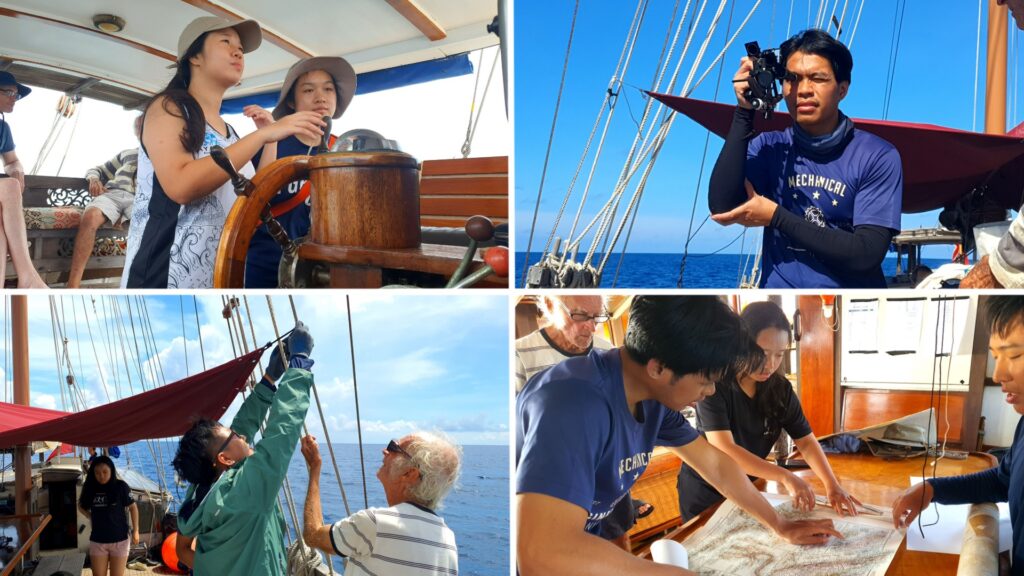
Over the course of ten days, the crew learnt a host of nautical skills on the fly—steering the ship, manning the ropes, tying nautical knots, manually raising the anchor, employing basic cartography to chart the ship’s course, and taking depth-sounding readings and records.
They also received a crash course in celestial navigation, including hands-on experience with using a sextant and the identification of significant constellations like the Big Dipper and Southern Cross to get their bearings out at sea. Blessed with clear skies and the absence of light pollution on most nights out at sea, the voyagers stargazed to their hearts’ content, treated to the sight of swathes of constellations, and even Venus and the Milky Way.
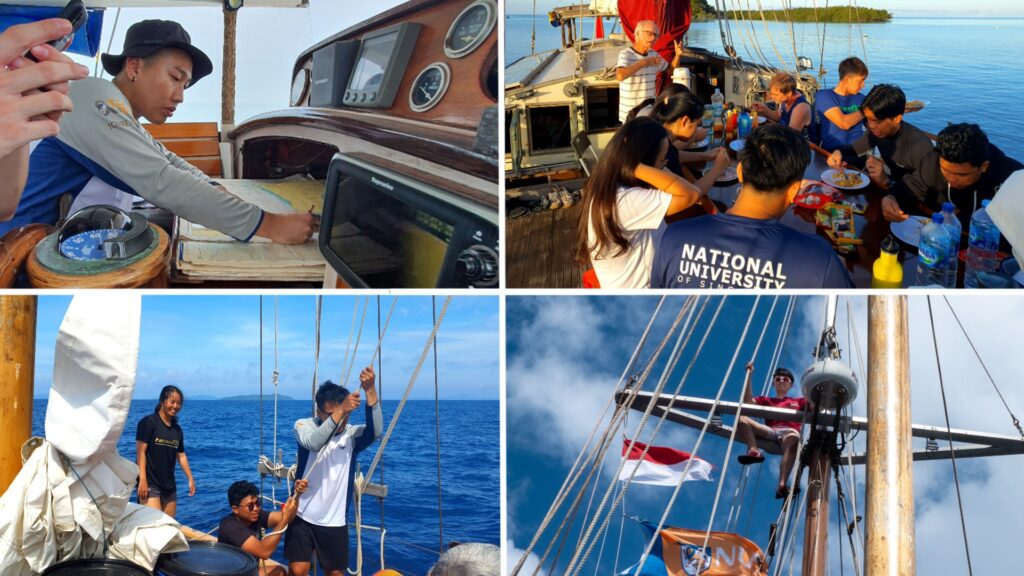
The journey was not all smooth sailing however— the voyagers contended with various challenges that took the wind out of their sails, such as a jammed rudder and anchor winching mechanism, and other small mishaps that they had to work together to overcome. Confronted with limited freshwater supply and limited electricity generated from the ship’s battery, they also gained a heightened appreciation for finite resources.
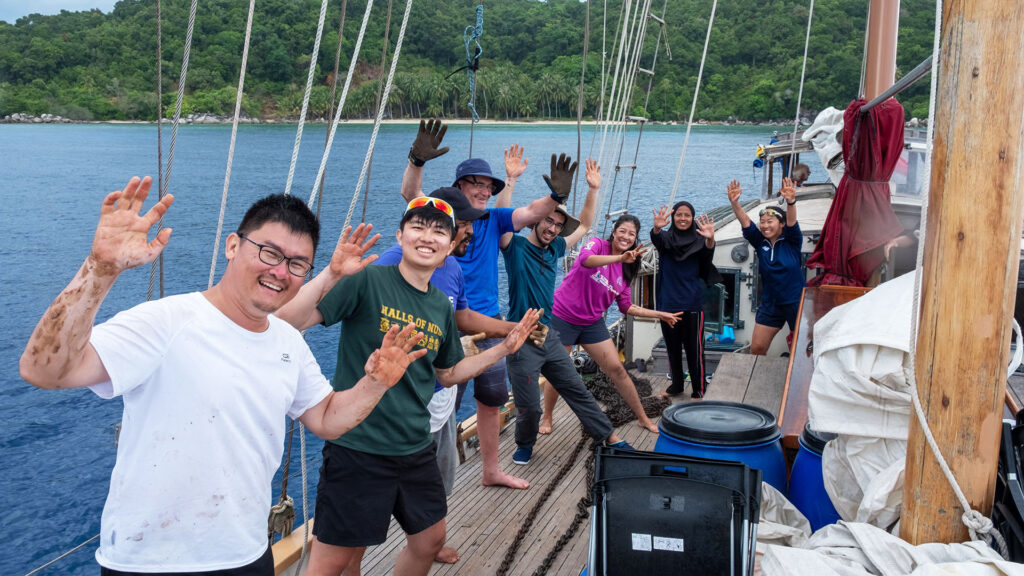
“One of the biggest challenges we faced was sailing the ship, an activity that requires accurate coordination, quick decision-making, and effective cooperation. The changing wind conditions and navigational challenges necessitated a cohesive team effort,” shared Tong Xinyao, a Year 1 Computer Science major.
“Through effective communication and a willingness to learn and help, we gradually grasped the basics of sailing. It was really fun and rewarding to see the sails up and enjoy the breeze on the deck after the hard work!” she quipped.
Connecting with Cocal communities: A Window into a Way of Life
The voyagers made a stop at Air Sena, a seaside village of stilt houses inhabited by the descendants of the Orang Laut, a nomadic seafaring people with a proud heritage of nautical knowledge and skill, and a resourcefulness in eking out a living from the sea.
Welcomed by the village chief Keng Lei, who led the voyagers on a tour through the village and graciously hosted them in his own home, the crew gleaned a first-hand understanding of the culture and economic structure of the local community.

Despite the communication barrier between the villagers and most of the crew, the locals’ palpable warmth and hospitality quickly broke the ice. The experience exploring the village and interacting with the villagers as the latter went about their daily lives opened a window into a way of life vastly disparate from the fast-paced urban existence the voyagers lead.
“I was surprised by how much of my perception of Indonesia was comprehensively challenged, while also teaching me so much more than I could on my own through books and the internet. Each island we visited possessed a unique culture, history, economy and perspective that stretched back more than hundreds of years,” Muhammad Harriz Adry Bin Ridzuan, a Year 4 major in Mechanical Engineering, reflected. “The villagers of Air Sena are good people with a rich history, who can teach us plenty about how to live contentedly and treat others with kindness in our work.”

Through conversing with Keng Lei and other locals on the ground, the voyagers also gained valuable insights into the various aspects and nuances of kampong life, from culture and history to economy and family structure. Of particular interest was the village’s unique religious composition—an agglomeration of Buddhists and Christians—thanks to its history as a Chinese settlement generations ago, before Christian missionaries arrived in the colonial era.
“Some of them speak Mandarin Chinese, and others speak Chinese dialects like Hokkien and Cantonese. What is more interesting is they have been partly assimilated into Indonesian culture, mainly speaking Bahasa Indonesia,” Timothy Timuari Li Zhi, a Year 4 major in Global Studies and Southeast Asian Studies, observed. “The Chinese temple we visited also featured a fusion of the Chinese deity Tua Pek Gong with local Indonesian influences, resulting in a fascinating syncretism between Chinese culture and Indonesian culture.”
Besides the cultural aspects of Air Sena, the voyagers also witnessed the village’s economy in action, from small-scale fishermen heading out for the day’s work to the village’s extensive floating kelongs that farm species like grouper and Napoleon wrasse as part of its growing fish export enterprise.
Living Biodiversities: A Study in Reef Ecology
No voyage would be complete without experiencing the flora and fauna of the region. The voyagers had ample opportunities to kayak, swim and snorkel in the crystal-clear cerulean waters of the Anambas Islands, located within the famed Coral Triangle that supports one of the richest marine biodiversities in the world.

Immersed in the world beneath the waves, they witnessed first-hand the extensive, thriving coral reefs of Tokong Malangbiru and Sagudampur, and the breathtaking smorgasbord of marine life they harbour. Among the numerous coral species spotted around islands and in lagoons were brain coral, staghorn coral, and table coral, mesmerising swathes of shapes and colours through which residents of the reef darted.
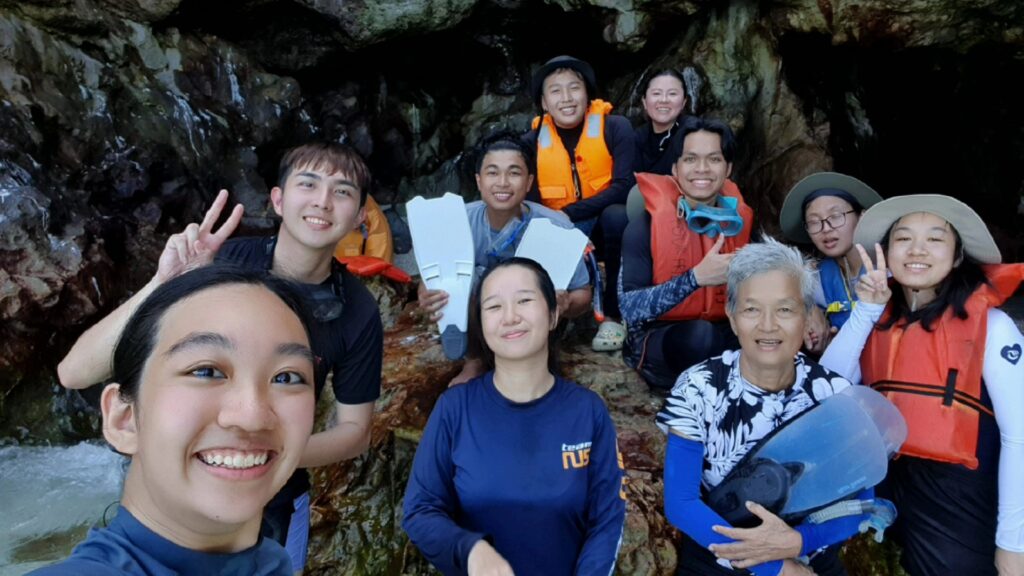
From blue sea stars, giant clams and anemones, to parrotfish, striped surgeonfish, clownfish, and multiple species of butterflyfish and damselfish, the voyagers observed the vibrant underwater ecosystem up close, and were even accosted by a particularly inquisitive longfin batfish. The experience was a first for some voyagers, cultivating an understanding and appreciation of the vast biosphere and the complex symbiotic interconnections between its various components.
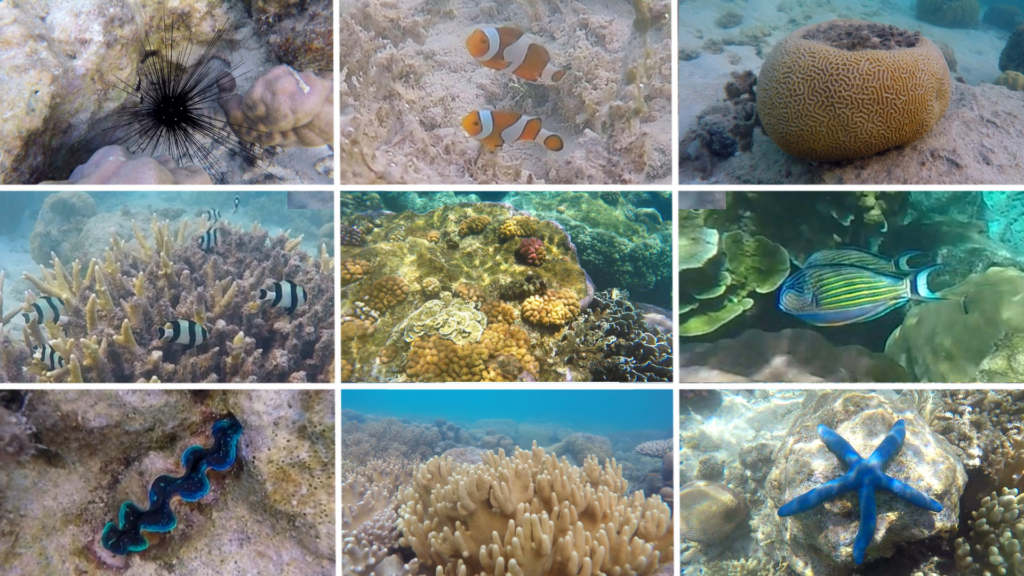
Besides being immersed in the beauty of reef ecology, the voyagers came up close with the sobering realities of climate change and global warming at some snorkelling locations—bleached, desolate reefs covered with detritus and devoid of the colour and splendour of the healthier reefs. Accompanied by Dedi Kurniawan, a Marine Science student from Universitas Maritim Raja Ali Haji (UMRAH) who shared his extensive knowledge on coral reefs, they also learnt about the damage that destructive fishing techniques such as trawling inflict on the ocean floor, and other threats to marine and reef biodiversity.
This is the first instalment of a two-part series on the NUS Seafarers “Understanding Anambas” STEER voyage and first appeared in NUSnews on 20 July 2023. Stay tuned for the second instalment of the voyagers’ experiences on the high seas and read more about the NUS Seafarers, or check out their YouTube channel!

